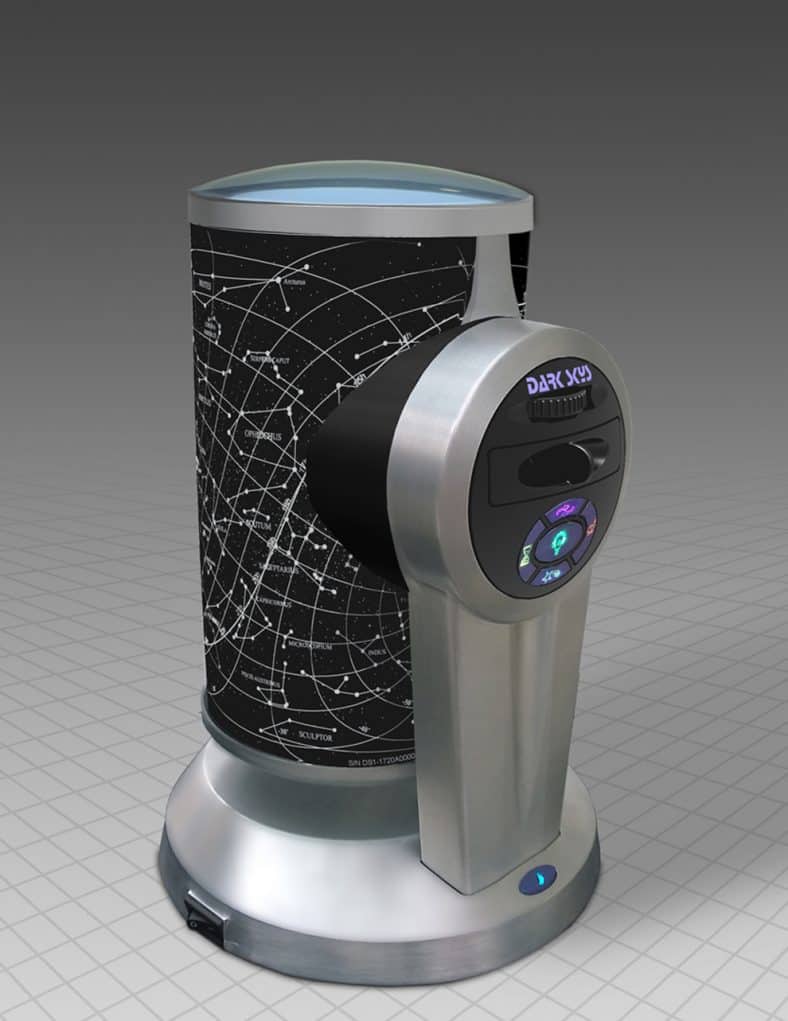Space. The final frontier. Also, something very difficult to see when you have to contend with clouds, light pollution and freezing cold weather, and that’s where a home planetarium comes in, with the Miller Engineering Dark Skys DS-1 aiming to give the best possible experience.
The Dark Skys DS1 planetarium is one of the best home planetarium money can buy thanks to the inbuilt night light and ability to project up to 4.1 million stars.
That experience comes with a hefty price tag, at the time of review it starts at $429.95 for the standard version and goes up to $539.95 for the Chrome version which substitutes the 1.4 million stars Northern disc for the 4.1 million stars Chrome on Glass star disc.
When you consider the previously reviewed Homestar Flux has 60,000 stars even the standard 1.4 million stars disc is a huge jump up in detail.
Keep in mind the above prices exclude shipping and any tax you may need to pay if you live outside of America.
What do you get with the DS-1 Planetarium?
Once I’d settled the customs fees the DS-1 was promptly delivered and arrive well packaged. You have the option to purchase additional discs alongside the DS-1, the manufacturer kindly sent me 3 discs to check out. Along with the discs and planetarium you get a protective bag, instructions, power supply and various adapters for different wall sockets.
The DS-1 stands 28cm / 11 inches high with a base diameter of 18cm / 7 inches. It has a premium feel thanks to the use of aluminium alloy in the construction. Each unit has it’s own serial number, I’ve been told at the time of review there are just 2000 units available.
Nightlight
Before talking about the projection element I’ve got to mention my favourite feature of the DS-1: it’s incredible night light. When powered off the main cylinder shows the constellations, when it goes dark press the night light button and the cylinder lights up with a soft white glow of over 4 million stars.
I’ve never seen anything like it and it’s a truly unique feature, great for those who’d like to look at the stars but don’t necessarily want a fan running. When you activate the projector the nightlight gently reduces in brightness until off.
DS-1 Projection
The main reason to purchase a planetarium is for its projection capabilities and this is where the DS-1 excels. The main cylinder can be rotated through 90 degrees to find the perfect projection angle, ideally projecting onto a smooth, flat, white surface such as a ceiling or wall.
Place a disc into the tray, press the power button, and it gets projected onto your chosen surface. As I mentioned earlier, I received 3 discs to test out for review, the standard 1.2 million stars disc, the special chrome 4.1 million stars discs and a scenic disc.
The projector has a focusing ring to ensure a crisp projection without any distortion.
Both star discs are very impressive, projecting far more detail than I’ve seen on previously reviewed planetariums. Pop some background music on, get comfortable and it’s a very relaxing experience.
Upgrading to the Chrome disc gets you millions more stars and it’s very impressive if you’re able to get up close to the projection (in my case standing on the bed) to see the millions of individual light points.
The scenic discs offer a different type of projection, the one I was sent was designed to give you a looking up at the sky in the woods feel, projecting a tree line, large moon and clouds and a lightning storm. Although not as detailed as the star discs they’re still impressive and give you a choice beyond looking at stars.
DS-1 Controls
As well as the power button and nightlight button there are controls to add a shooting star, control the projection rotation (still, clockwise or anticlockwise), and the rotation speed. These controls are softly backlit making them easy to use in the dark, with different coloured lights used to represent the different button settings.
How Does the DS-1 Home Planetarium Compare to the Sega Toys Homestar Flux Planetarium?
The DS-1 Home Planetarium offers stunning star projections, but the Sega Toys Homestar Flux Planetarium boasts advanced features like adjustable focus and shooting star effects. While both provide a mesmerizing experience, the Homestar Flux stands out for its versatility and high-quality performance.
How Does the DS-1 Home Planetarium Compare to the Oregon Scientific WS683 DreamScience?
The DS-1 Home Planetarium offers a unique stargazing experience with its advanced projection technology. However, the Oregon Scientific WS683 DreamScience takes it a step further with its immersive 360-degree rotation and constellation guide. Both devices provide a mesmerizing view of the night sky, but the WS683 offers a more comprehensive experience.
Which Home Planetarium Option is Better for Stargazing: DS-1 or Omegon Universe2go?
When considering a home planetarium for stargazing, it’s essential to do an Omegon Universe2go planetarium review. Both the DS-1 and Omegon Universe2go offer unique features for stargazing enthusiasts. The Omegon Universe2go stands out for its immersive experience and interaction with real-time sky mapping, making it a top choice for stargazing.
Should I buy the DS-1 Planetarium?
There’s no doubt the DS-1 is the best planetarium I’ve ever reviewed. It also happens to be the most expensive, the biggest hurdle for most shoppers. If money is no object and you want the very best, with the most starts and a wide range of additional discs then you absolutely should purchase the DS-1.
However, if you’re on a budget you’d be better off checking out the Homestar Flux. It doesn’t have as many stars or the brilliant nightlight feature, but it also comes without the high price tag.
At the time of review, the DS-1 is only available from the manufacturer via httpss://dark-skys.com/
>>//<!;
entry.parentNode.insertBefore(script, entry);
})();
//]]>




